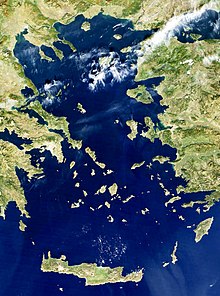Earthquake in the Gulf of Evia 426 BC Chr.
The earthquake in the Gulf of Evia in 426 BC In the summer of 426 BC devastated The coasts of the Gulf of Malia and the Northern Gulf of Evia in Greece . The earthquake triggered a tsunami that flooded coastlines and cities. The intensity of the earthquake is estimated on the basis of the historically transmitted descriptions of the damage to XI according to the MSK scale .
The event was the occasion for the Greek historian Thucydides to fathom the cause of the tidal wave. He came to the conclusion that an earthquake must have caused the tsunami. Thucydides was the first scientist to put the quake and the wave into a cause-effect relationship. His predecessor Herodotus attributed the Potidea tsunami to Poseidon's revenge .
Historical records
The earthquake in the Gulf of Evia is one of a series of earthquakes in the summer of 426 BC. BC, which in the Peloponnesian War forced the Spartans to break off the invasion of Attica . The geographer Strabo reported that parts of the Greek islands were flooded, cities were devastated and rivers changed their course permanently. The tsunami hit the coast in the Gulf of Maliakos in three places and even reached cities three quarters of a mile from the sea. The tsunami hit with such force that a trireme was lifted from its dock and hurled over the city wall.
Thucydides left a report in which he recorded two of the characteristic features of a tsunami, namely the rapid sinking of the sea level and the actual wave:
“Around the time of the earthquake, the sea in Orobiai on Evia withdrew from its usual course of the coast, came back as a huge wave and flooded a large part of the city, so that now the sea is what was once land, just as the city dwellers perished, who could not escape to higher ground in time. A similar flood occurred in Atalanta, the island off the Opuntian-Locrian coast, where parts of an Athenian fortification were washed away and one of two ships dragged onto the beach was destroyed. The sea also retreated a little from Peparethos , but without a subsequent flood, but an earthquake brought part of the city wall, the city hall and some other buildings to collapse. "
He concluded:
“In my opinion, the earthquake must be seen as the cause of this phenomenon. At the point where its tremors were most violent, the sea has retreated, only to suddenly return with increased violence. This is what causes the flooding. I don't understand how such a catastrophe could have happened without the earthquake. "
Scientific processing
While the epicenter of the quake has not yet been determined, the reason for this is a movement of the crust along the faults in the Gulf of Evia rather than a series of submarine landslides. The movements at the faults are related to the plate tectonic processes in the Ionian Sea , where the African plate is subducted to the northeast under the Anatolian Bloc, part of the Eurasian plate .
Incompatibilities in the descriptions of Strabo and Thucydides led scientists from the Institute of Geodynamics at the National Observatory of Athens and the Geological Institute of the Aristotle University of Thessaloniki, after comparing texts and using archaeological findings, to assume that it was the one called earthquake of 426 BC Chr. Known earthquake could have acted two different earthquakes.
Individual evidence
- ^ A b c John Antonopoulos: The Tsunami of 426 BC in the Maliakos Gulf, Eastern Greece. In: Natural Hazards. Volume 5, 1992, pp. 83-93.
- ↑ Earthquake catalog for the countries of the EU (as of 1990), Switzerland and Austria. ( Page no longer available , search in web archives ) Info: The link was automatically marked as defective. Please check the link according to the instructions and then remove this notice. BGR, Hanover
- ↑ a b Thucydides 3, 89, 2-5 .
- ↑ TC Smid: 'Tsunamis' in Greek Literature . Greece & Rome, 2nd Ser., Vol. 17, No. 1, April 1970, pp. 103 f.
- ↑ Herodotus 8,129 .
- ↑ Thucydides 3.89.1 .
- ↑ a b c Strabo , 1,3,20 .
- ↑ Ulrike Kastrup: Scenario: Earthquake. ( Memento of the original from November 28, 2006 in the Internet Archive ) Info: The archive link was inserted automatically and has not yet been checked. Please check the original and archive link according to the instructions and then remove this notice. ETH Zurich (PDF, 424 kB)
- ^ I. Papaioannou, GA Papadopoulos and S. Pavlides: The Earthquake of 426BC in N. Evoikos Gulf Revisited: Amalgamation of two Different Strong Earthquake Events ?. Proceedings of the 10th International Congress, Thessaloniki, April 2004. Bulletin of the Geological Society of Greece, Vol. 36, pp. 1477–1481, 2004. (pdf, 184 kB)
literature
- John Antonopoulos: The Tsunami of 426 BC in the Maliakos Gulf, Eastern Greece. In: Natural Hazards. Vol. 5, 1992, pp. 83-93.
- TC Smid: 'Tsunamis' in Greek Literature. In: Greece & Rome , 2nd Ser., Vol. 17, No. 1, April 1970, pp. 100-104.
Coordinates: 38 ° 52 '9.4 " N , 22 ° 36" 59.8 " E
